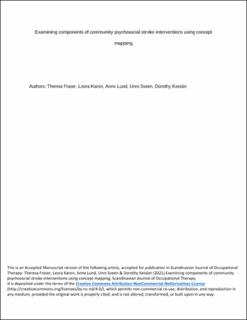Examining components of community psychosocial stroke interventions using concept mapping
Peer reviewed, Journal article
Accepted version
Permanent lenke
https://hdl.handle.net/11250/2986585Utgivelsesdato
2021-06-28Metadata
Vis full innførselSamlinger
Originalversjon
Scandinavian Journal of Occupational Therapy. 2021, . https://doi.org/10.1080/11038128.2021.1933172Sammendrag
Background: Stroke impacts psychosocial well-being and engagement in occupation. Psychosocial interventions reduce depression and anxiety but may not impact occupation. Knowledge of key processes and components of community psychosocial stroke interventions can inform future intervention development.
Aim/objective(s): To determine the essential elements common to three psychosocial interventions for stroke survivors.
Material(s) and method(s): Concept maps were created for three community psychosocial stroke interventions based on published literature and communication with researchers who tested the intervention with stroke survivors. The concept maps were then compared to identify common elements. Ongoing communication with researchers ensured accurate representation of each respective intervention.
Results: Similarities in intervention processes and components included, support for autonomy; individualized information exchange; coping, life skill development, and adaptation support; competence development; and the incorporation of goals. Differences included intervention delivery (individual versus group), and the avenues in which psychosocial needs are addressed (occupation versus dialogue).
Conclusions: Concept mapping identified similarities among the three interventions that can be best understood using Self-Determination Theory. Clinicians may utilize findings revealed in the process to inform evidence-based psychosocial stroke interventions.
Significance: Knowledge of key “active ingredients” for psychosocial community stroke interventions, can be used to guide clinical reasoning and inform development of interventions.

